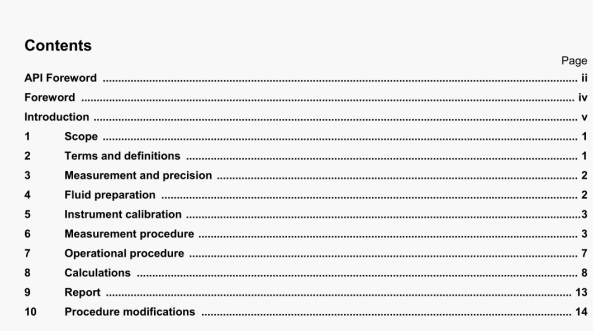API RP 13M-4:2006 pdf download.Recommended Practice for Measuring Stimulation and Gravel-pack Fluid Leakoff Under Static Conditions.
7.1 Assembly
There are three procedures to assemble fluid-loss cells depending on the porous medium. These procedures
are described below.
7.1.1 Filter-paper medium
Place the spacer at the bottom of the cup and a 38 pm (400 US mesh) screen on the spacer. Making sure the bottom valve is closed, introduce the base fluid into the cell to assure all the dead volume is filled. Then, place three 8 pm pore-size cellulosic filter papers 3) on top of the screen. Assemble the top and close the upper valves. Place the cell into a heat jacket and connect the back-pressure receiver if the test temperature is above the boding point of the fluid. Connect the pressure line to the top valve. The back-pressure receiver and heat jacket should be operated according to the manufacturer’s procedure.
7,1.2 Natural core
Place the spacer, if applicable, at the bottom of the cup. Making sure the bottom valve is closed, introduce the base fluid into the cell to assure all the dead volume Is filled. Then, place the pre-saturated core plug of 2,54cm (1,0 in) diameter and 2,54cm (1,0 in) length in a core holder and place it inside the cell according to the manufacturer’s procedure, Assemble the top and close the upper valves. Place the cell into a heat jacket and connect the back-pressure receiver if the test temperature is above the boiling point of the fluid. Connect the pressure line to the top valve. The back-pressure receiver and heat jacket should be operated according to the manufacturer’s procedure.
7.1.3 SynthetIc core
Place the spacer at the bottom o( the cup and a pre-saturated ceramic disk, 6,35 cm (2,5 in) in diameter and 0,635 cm (0.25 In) thick or a pre-saturated synthetic core of swnilar size on top of the spacer. Making sure the bottom valve is closed, introduce the base fluid into the cell to assure all the dead volume is filled and assemble the porous medium. Assemble the top and close the upper valves. Place the cell into a heat jacket and connect the back-pressure receiver it the test temperature is above the boiling point of the fluid. Connect the pressure line to the top valve. The back-pressure receiver and heat jacket should be operated according to the manufacturer’s procedure.
7.2 Test procedure
Apply a constant pressure to the cell, typically 6 895 kPa (1 000 psi) above the intended back-pressure, by opening the top valve. Allow the fluid to reach test temperature. Optionally, a shut-in time may be applied. Once at test temperature (or completion shut-in time), open the bottom valve and collect the filtrate into a graduated cylinder and record the collected volume as a function of time. Typically time intervals of 1 mm, 2 mm, 4 mm, 9 mm, 16 mm, 25 mm and 36 mm are used. The volume may be collected in a container, making sure the evaporation is minimized (the volume may be calculated from fluid mass by collecting the fluid in a tared container). These data are used for calculating spurt loss, the fluid-loss coefficient or the completion fluid’s filtrate viscosity.
API RP 13M-4:2006 pdf download
